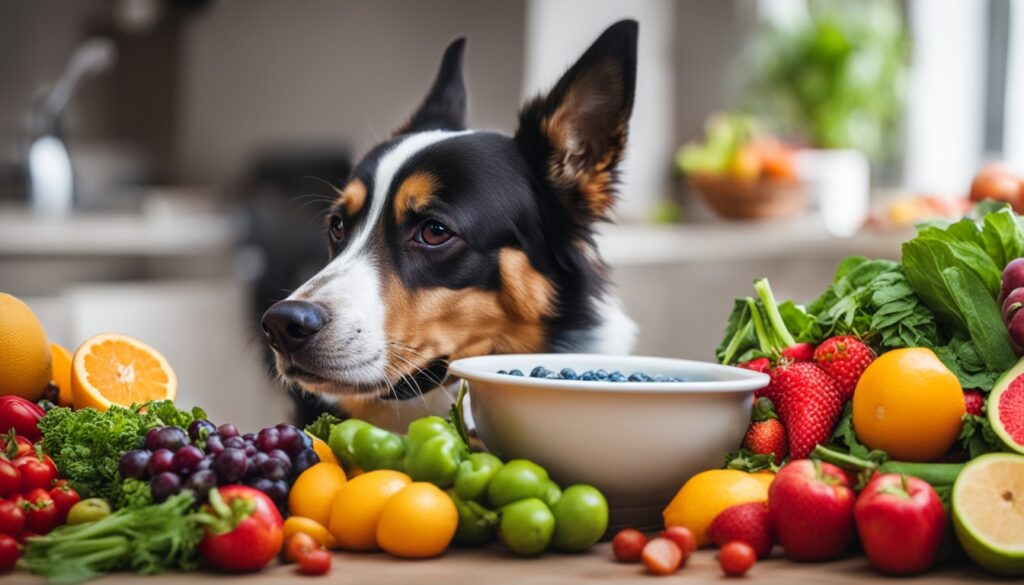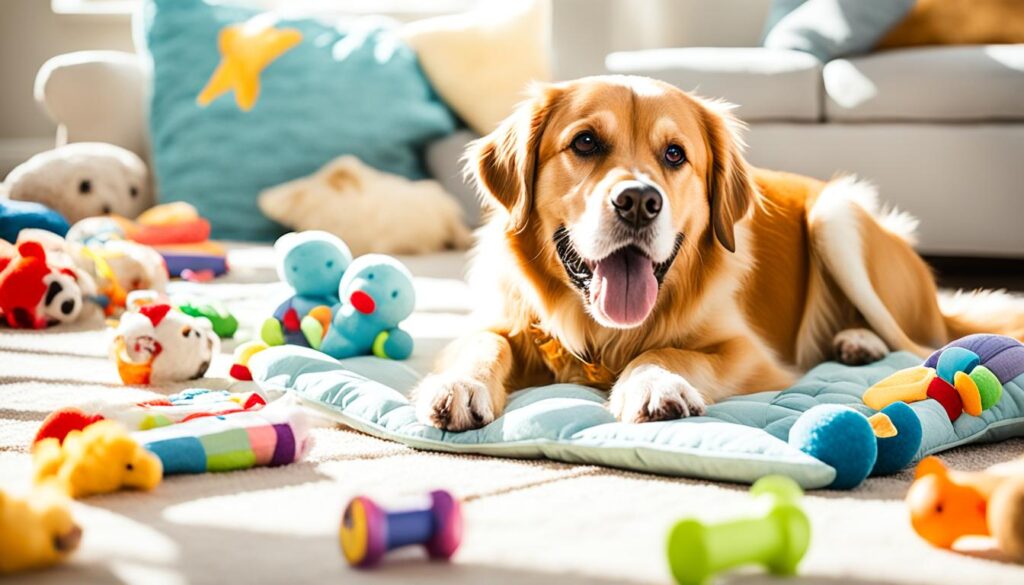As an Amazon Associate I earn from qualifying purchases.
Imagine it’s 2016, and you’re on a farm with Willie, your loyal nine-and-a-half-year-old sheepdog. The weather is just right, in the mid-twenties. But Willie has hurt his shoulder and can’t work anymore. You’re left wondering how to keep your dog happy.
Every dog owner has their own challenges, like Tootsie’s tummy troubles or Maggie’s odd behaviors. But don’t worry! We’ve found the seven best ways to make your dog happy. These tips will bring more joy to your dog than a squirrel party in your yard. Are you ready to learn how to make your dog happy? Let’s get started, with our tails held high!
Key Takeaways
- Understanding your dog’s unique needs is crucial for their happiness
- Regular exercise and mental stimulation are key to a dog’s well-being
- Creating a safe, comfortable environment enhances canine happiness
- Tailoring affection to your dog’s preferences strengthens your bond
- Consistent training and socialization contribute to a well-adjusted, happy dog
Understanding Your Dog’s Unique Needs
Ever wonder why your furry friend acts the way they do? It’s all about understanding their unique needs. Just like humans, dogs have specific requirements for a happy, healthy life. Let’s dig into what makes your pooch tick!
Physical Requirements
Your dog’s body is a temple, and it needs proper care. A balanced diet tailored to their life stage is crucial for maintaining a strong immune system. Did you know that as dogs age, their nutritional needs change? Senior dogs often require special dietary plans to keep them spry and healthy.
Emotional Necessities
Dogs are emotional creatures. When their feelings aren’t addressed, they might act out. Notice your pup chewing up your favorite shoes? It could be a cry for attention! Providing love, security, and plenty of playtime can work wonders for your dog’s emotional well-being.
Social Interaction Demands
Ever seen a dog who’s never met another pup? It’s not a pretty sight. Socialization is key to preventing behavioral issues like aggression or nervousness. Regular playdates and interactions with other dogs can help your furry friend become a well-adjusted social butterfly.
| Need | Impact on Dog Health | Effect on Dog Behavior |
|---|---|---|
| Exercise | Improves physical fitness | Reduces destructive behavior |
| Training | Enhances mental stimulation | Boosts confidence and understanding |
| Socialization | Supports emotional well-being | Prevents aggression and nervousness |
Remember, every dog is unique. By tuning into your pup’s individual needs, you’re paving the way for a happier, healthier furry companion. Now that’s something to wag your tail about!
The Power of Quality Time with Your Furry Friend
Spending quality time with your dog is key to their happiness and well-being. It’s more than just fun; it’s crucial for a strong bond. Engaging in activities and enrichment builds a lifelong connection.
Take your pup on exciting adventures! Hiking is great for mental stimulation, security, and fitness for both of you. It’s a budget-friendly way to bond and enjoy nature. For something different, try pet events or carnivals. These outings teach your dog to handle crowds and stay close to you.
Looking for more excitement? Agility classes are a great choice. They boost your dog’s confidence and self-control, and improve how you communicate. Or, if you’re feeling less energetic, a lazy day can be rewarding too. Activities like a photo shoot, shopping, or just napping together strengthen your bond and show your dog how much you care.
“The time you spend with your dog is never wasted. It’s an investment in love, trust, and companionship.”
Quality time doesn’t always need to be big gestures. Daily walks are crucial for mental stimulation and prevent behavior problems from too much energy. Even a short lunch date outside can make your time together special.
| Activity | Benefits |
|---|---|
| Hiking | Mental stimulation, fitness, bonding |
| Agility classes | Confidence building, improved communication |
| Daily walks | Mental stimulation, energy release |
| Lazy day activities | Strengthening bond, relaxation |
By focusing on quality time and enrichment activities, you’re doing more than making your dog happy. You’re building a rewarding relationship that benefits both of you. So, grab that leash and start making memories!
Nurturing a Healthy Lifestyle for Canine Happiness
Your furry friend’s well-being is in your hands. A happy dog starts with a healthy lifestyle. This includes proper nutrition, regular exercise, and preventive care. Let’s explore these key parts of dog health.
Balanced Nutrition
Good dog nutrition is crucial for a healthy pup. Many pet owners don’t realize its importance, which can harm their dog’s health. Choose high-quality commercial foods or make homemade meals that are balanced.
Remember, the diet should match your dog’s age, size, and how active they are.

Regular Exercise Routines
Dog exercise is key for their physical and mental health. It helps prevent obesity and other behavioral problems. Tailor your dog’s exercise to their breed and how energetic they are.
Daily walks, playtime, and interactive toys can keep your pup fit and happy.
Preventive Health Care
Regular vet check-ups are crucial for your dog’s health. They help with preventive care and catch problems early. Don’t forget about dental care – it’s important for overall health.
Grooming like brushing, bathing, and trimming nails also helps your dog stay well.
| Aspect | Importance | Tips |
|---|---|---|
| Nutrition | Foundation of health | Balanced diet, quality food |
| Exercise | Physical and mental health | Daily walks, playtime |
| Preventive Care | Long-term well-being | Regular vet visits, dental care |
By focusing on these three areas of dog health, you’re helping your furry friend live a happy, healthy life. Remember, a little effort can make a big difference in keeping that tail wagging!
Mental Stimulation: Keeping Your Dog’s Mind Active
Ever wondered why your furry friend seems bored? It’s time to spice up your pup’s life with some brain-boosting activities! Dog enrichment isn’t just about physical exercise – it’s about giving that canine noggin a workout too.
Imagine your dog’s delight when you turn a simple walk into a scent-sational adventure. Changing routes can spark curiosity and lower stress levels. It’s like giving your pup a new book to sniff every day!
Got a food-motivated mutt? Try scatter feeding! Hide kibble around the house and watch your four-legged detective go to work. It’s not just fun – it’s a mental workout that’ll leave your pup feeling accomplished and tired.
Dog training doesn’t have to be a chore. Short, 5-15 minute sessions can be mentally exhausting for dogs. It’s like doggy CrossFit for the brain! Plus, it releases feel-good dopamine, making your pup happier than a squirrel in a nut factory.
| Activity | Benefits | Time Required |
|---|---|---|
| Scent Walks | Decreased heart rate, lower stress | 15-30 minutes |
| Puzzle Toys | Reduced anxiety, increased focus | 10-20 minutes |
| Training Sessions | Enhanced cognitive abilities, sense of accomplishment | 5-15 minutes |
Remember, a mentally stimulated dog is a happy dog. So, grab those puzzle toys, mix up your walks, and get training. Your pup’s tail will be wagging with joy!
Creating a Safe and Comfortable Environment
Your furry friend deserves a cozy castle to call home. Let’s explore how to craft a dog-friendly haven that’ll make tails wag with joy. A comfy space isn’t just about luxury – it’s crucial for your pup’s health and behavior.

Cozy Sleeping Areas
Dogs need their beauty sleep – about 12 to 14 hours daily! Create a snug spot with a soft bed and blankets. Senior dogs might need extra padding for those achy joints. Place the bed away from drafts and noise for uninterrupted snoozing.
Secure Play Spaces
Safety first, fun second! Puppy-proof your home by removing hazards and securing loose items. Did you know 30% of dog owners worry about their pets escaping? Install sturdy gates or create a designated play area. Fill it with toys – the pet toy market grows 7% annually, so there’s plenty to choose from!
Establishing Comforting Routines
Dogs thrive on predictability. Set regular times for meals, walks, and playtime. This structure helps reduce anxiety and promotes good behavior. About 70% of dogs get spooked by loud noises, so create a quiet, safe space for stormy days. Building confidence in dogs through routines can significantly improve their overall well-being.
“A dog’s home is their castle. Make it a place where they feel safe, loved, and entertained.”
Remember, a happy home leads to a happy hound. By creating a safe, comfortable environment, you’re setting the stage for a lifetime of tail-wagging memories!
Seven Best Ideas to Have a Happy Dog
Your furry friend’s happiness is key for a great life together. Let’s look at seven top ideas for a happy dog. These ideas mix dog training with fun dog activities.
Provide Appropriate Exercise
Adjust exercise to fit your dog’s breed and energy. Daily walks, fetch, or jogging keep them healthy and happy. A tired dog is a happy dog!
Increase Playtime
Play fun games like tug-of-war or hide-and-seek. These games strengthen your bond and give them mental stimulation. Puzzle toys can keep them busy for hours.
Never Stop Training
Keep training your dog to keep their mind sharp. Try teaching new tricks or join obedience classes. This keeps them from getting bored and helps them behave well.
Learn About Dog Culture
Learn about your dog’s breed to better meet their needs. Research their history and instincts for the right activities and care.
Give Your Dog a Say
Let your pup choose their daily routine. Let them pick their walking path or toy. This freedom boosts their confidence and happiness.
Provide Toys and Chews
Give a variety of toys to keep them interested. Change them often to keep things exciting. Chew toys help them naturally and keep their teeth healthy.
Learn Doggie Massage
Learn canine massage. It’s a great way to relax your dog, improve blood flow, and strengthen your bond. It’s also a great way to unwind after a busy day.
| Activity | Benefit | Frequency |
|---|---|---|
| Daily Walks | Physical Exercise | 1-2 times daily |
| Puzzle Toys | Mental Stimulation | 2-3 times weekly |
| Training Sessions | Mental Exercise | 15 minutes daily |
| Playtime | Bonding | 30 minutes daily |
| Doggie Massage | Relaxation | 2-3 times weekly |
Using these seven best ideas will make your dog’s life joyful and exciting. A mix of exercise, mental challenges, and love is key to their happiness.
Tailoring Affection to Your Dog’s Preferences
Every pup is unique, and it’s important to know what they like and don’t like. Dogs have their own way of showing and receiving love, just like humans do. By paying attention to how your dog acts, you can show them love in ways they enjoy.
It’s key to watch how your dog reacts to different kinds of affection. Some dogs love belly rubs, while others prefer head pats. Look for signs like a wagging tail and a relaxed body to see if they’re happy.
- Offer different types of affection (petting, scratching, hugging)
- Watch for signs of enjoyment or discomfort
- Note which actions elicit positive responses
- Repeat favored actions more frequently
Being consistent is important to make good behavior stick. Experts say giving praise or treats right away can make your bond stronger. But remember, don’t give too many treats to keep your dog at a healthy weight.
“A dog is the only thing on earth that loves you more than he loves himself.” – Josh Billings
When you show love in ways your dog likes, you’re not just making them happy. You’re building trust and making your bond stronger. This way, you make your dog feel more comfortable and happy, leading to a better life together.
| Affection Type | Possible Positive Reactions | Possible Negative Reactions |
|---|---|---|
| Belly Rubs | Relaxed posture, leg kicking | Turning away, getting up |
| Head Pats | Leaning in, closing eyes | Ducking, moving away |
| Hugs | Staying still, tail wagging | Stiffening, trying to escape |
| Verbal Praise | Perked ears, excited movement | Ignoring, no reaction |
The Art of Canine Communication
Learning how dogs communicate is key to a happy life with your pet. As more people care for dogs, knowing how to talk to your dog is vital. It helps with training and managing their behavior.
Understanding Body Language
Dogs talk a lot without words. A wagging tail doesn’t always mean they’re happy. A yawn might show they’re stressed, not tired. By understanding these signs, you can know how they feel and what they need.
Responding to Vocal Cues
Dogs make sounds to talk to us. Each sound means something different. Knowing what they’re saying helps you answer their needs or worries.
Building Trust Through Consistent Interaction
Being consistent builds trust with your dog. Regular, positive times together make your bond stronger. It makes your dog feel safe and understood.
| Communication Aspect | Before Understanding | After Understanding |
|---|---|---|
| Reactive Behavior | 75% viewed negatively | 25% viewed negatively |
| Training Approach | 60% dominance-based | 10% dominance-based |
| Owner Mindfulness | 30% practiced | 80% practiced |
Using these tips, you and your dog will have a great relationship. Every time you talk, you’re learning and growing together. Leave your ego behind, play happily, and see amazing changes in your bond with your dog.
Socialization and Playdates: Fostering Canine Friendships
Want a happy, well-adjusted pup? Think dog socialization! It’s key to raising a confident canine. Early socialization can greatly affect your dog’s future behavior. Puppies that miss this stage might become fearful or aggressive towards others.
Ready to help your pup become a social butterfly? Start early! The best time for socializing is from early puppyhood to about four months old. This is your chance to shape your dog’s life approach. Even adult dogs can learn new social skills with patience and positive reinforcement.
Here’s a fun idea: host a puppy party! Invite friends, family, and their dogs for some fun under supervision. This lets your pup meet different people and dogs in a safe setting. Remember, quality is more important than quantity in dog activities.
“Almost all dogs want to be part of their ‘pack’. Including them in family activities is key to their happiness and social development.”
Keep your dog’s activities interesting to keep them engaged. Try obedience classes, dog park visits, or playdates with other dogs. These activities boost your pup’s confidence in social situations. Just ensure they’re up-to-date on vaccinations before going out.
Socialization is a lifelong process. Keep introducing your dog to new experiences, sights, and sounds. With consistent positive interactions, your dog will become a social superstar in no time!
Addressing Behavioral Challenges for a Happier Dog
Got a pup with a few quirks? You’re not alone! A whopping 45% of dog owners struggle to pick the right chow for their furry friends. But fear not, tackling dog behavior and nailing dog training can turn your pooch into the happiest hound on the block.
First things first, let’s talk grub. 60% of pet parents are eyeing tailored dog foods to zap those pesky health hiccups. Think joint health, weight management, and allergy busters. Remember, a well-fed dog is a happy dog!
Now, onto the fun stuff! 70% of dog owners are hitting the pavement daily for walks or play sessions. It’s not just about burning energy – it’s a mental workout too. Speaking of which, 55% of owners are using toys and puzzles to keep those doggy brains buzzing.
| Activity | Percentage of Dog Owners | Benefits |
|---|---|---|
| Daily walks/play | 70% | Exercise, mental stimulation |
| Toys and puzzles | 55% | Mental enrichment |
| Quality time | 70% | Bonding, preference-based activities |
But here’s the kicker – only 30% of owners are sticking to the recommended bath time schedule. Yikes! And 40% are skipping the nail trim. Trust us, your pup’s paws will thank you for a little TLC.
Remember, a happy dog is all about balance. Mix up the routine with some puzzle feeders, scatter treats for a sniff-tastic adventure, and keep that reward-based training going strong. Your four-legged friend will be wagging their tail in no time!
Conclusion
You’ve discovered the seven best ways to make your dog happy. With over 40% of U.S. homes having a dog, making pets happy is a big deal for many. It’s more than just fun and affection for your dog.
These strategies focus on your dog’s body and feelings. Did you know dogs sleep 12-14 hours a day? They need a comfy place to rest. Regular grooming, vet visits, and a healthy diet are also important for their happiness.
Dogs can feel sad or anxious, just like people. By using these seven tips, you’re not just making your dog happy. You’re building a strong, loving bond with them. So, get that leash, pull out a puzzle toy, and start your journey to a happier dog. Your dog will show their love and loyalty forever!
FAQ
How can I understand my dog’s unique needs?
Why is quality time with my dog important?
How can I ensure my dog’s health and happiness?
What mental stimulation activities can I do with my dog?
How can I create a safe and comfortable environment for my dog?
What are the seven best ideas to have a happy dog?
How can I show affection to my dog in a way they prefer?
How can I better communicate with my dog?
Why is socialization important for my dog?
How can I address behavioral issues affecting my dog’s happiness?
As an Amazon Associate I earn from qualifying purchases.

